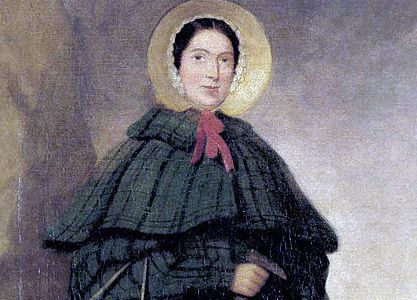Mary Anning and Elizabeth Philpot were two 19th-century English fossil collectors. Although the two came from different worlds, they shared a common hobby: the search for fossils on the beaches of Lyme Regis, an activity not very well seen for two young ladies of the time. They were two relevant and pioneering people in the field of fossils and paleontology. Their discoveries allowed people to realise that animals existed on Earth many millions of years ago, and therefore the Bible's version of creation should not be taken literally.
The first recognised woman geologist was the British Etheldred Benett (1776-1845) who worked in Wiltshire but did not become as famous as Mary Anning.

Mary Anning
n. Lyme Regis — m. 09-03-1847
Periodo de actividad: 1811 — 1845
Clasificación geográfica: Europa > Reino Unido
Movimientos socio-culturales
Grupos por ámbito de dedicación
Científicas > Geólogas / Geofísicas
Contexto de creación femenina
Reseña
Anning was a working-class woman, born into a poor family in a very strict, patriarchal, and very classist society. She grew up to be an important paleontologist of her generation, but unrecognized for her gender and her class.
She began digging on that cobbled shoreline as a child, intending to make some money to help her family. At the age of 12 she had already removed the ichthyosaur, the complete skeleton of the plesiosaur was discovered at the age of 24 and, shortly after, part of a pterodactyl. The rest of her life she continued to live and search for fossils in Lyme Regis where she died at the age of 47.
Actividades
Justificaciones
Biografía
Mary Anning was born in 1799 in the town of Lyme Regis (England) into a humble family. Her father was a cabinetmaker and supplemented her salary by selling fossils to tourists visiting the city. Mary and her brother Joseph always accompanied their father to collect fossils on the steep and slippery walls of the Jurassic Coast. On one of these days her father slipped and died. Since then, the brothers had to dedicate themselves full time to the collection and sale of fossils to earn a living.
Among Mary's main discoveries are the following. In 1811, together with her brother, they located the skeleton of an ichthyosaur –half fish, half reptile– that lived in the Mesozoic era. In 1824 Mary discovered the skeleton of a plesiosaur –a creature with a body similar to a current crocodile–. In 1827 she dried the inner shell of a belemnite – similar to a squid or cuttlefish.
Mary not only collected the fossils, but also drew, classified, and documented them, which allowed her to make hypotheses and draw conclusions. Many geologists visited Mary to work with her on the collection, definition, and classification of fossils, such as George W. Featherstonhaugh, William Buckland or Henry De la Breche.
Mary Anning died in 1847 at Lyme, in whose church she was buried. In this temple, a stained-glass window was built in her honor with an inscription that highlighted her work in the field of Geology. The Royal Society of London places Mary Anning among the ten most important British women in science.
Her findings: ichthyosaurs, plesiosaurs and pterosaurs supported the theory that in the past there had been an "Age of Reptiles" and were also key to the development of Paleontology. Although her work did not receive initial recognition –for example, she was not cited in research publications–, in the end the scientific community would recognize her merits. From 1838 she received an annual salary from the British Association for the Advancement of Science and Geological Society of London made her the first Honorary Member of the Dorset County Museum.
The discovery of a new type of ichthyosaur, in 2015, and the publishing in the 'Journal of Vertebrate Paleontology' was baptized with the name 'Ichtyosaurus annigae', in honor of her.
Last year (2020), Anning returned from oblivion with the film 'Amonnite', directed by Frances Lee and starring Kate Winslet.
Obras
Bibliografía
- Fernández M.D., Uskola A., Nuño T., (2006). ” Mujeres en la historia de la Geología (I): Desde la antigüedad hasta el siglo”,. Enseñanza de las de Ciencias de la Tierra, AEPETEC, 24-01-2022, https://raco.cat/index.php/ECT/article/view/106798/133566%20
- Wikipedia (24-01-2022) https://es.wikipedia.org/wiki/Mary_Anning
- Zamorano, E, (2021) “Vida y obra de la olvidada Mary Anning”. El confidencial, Titania Compañía editorial, 24-01-2022, (24-01-2022) https://www.elconfidencial.com/alma-corazon-vida/2021-03-03/mary-anning-ciencia-historia-paleontologa_2972063/
- Montero, Rosa (2014) “Mary Anning en los comienzos de la paleontología moderna” , Mujeres con Ciencia, UPV, (24-01-2022) https://mujeresconciencia.com/2014/05/28/mary-anning-en-los-comienzos-de-la-paleontologia-moderna/
Enfoque Didáctico
-Biology-geology of 4th of ESO.